he/him | I post random stuff, whatever has to do with my hyperfixations | Current hyperfixations: entomology, mycology, marine biology, paleontology.
Don't wanna be here? Send us removal request.
Text
@writingraccoon you are totally right ! This is an awesome mushroom ! ! ! I love when nature just *natures* (is that a word ! ? ! ? it kind of should be ! ) <333
You are also completely right about a dress based on this fungus ! It would be so gorgeous ! ! But sewing it would be such a pain-staking job, it would be worth it but still ! Just imagine the amount of pleats you would have to sew ! ! And where to start on a flowing fabric that can hold its shape amazingly well ! ? ! ?
It would indeed be stunning ! If someone ever makes a dress like this, it would be so freaking cool ! ! !
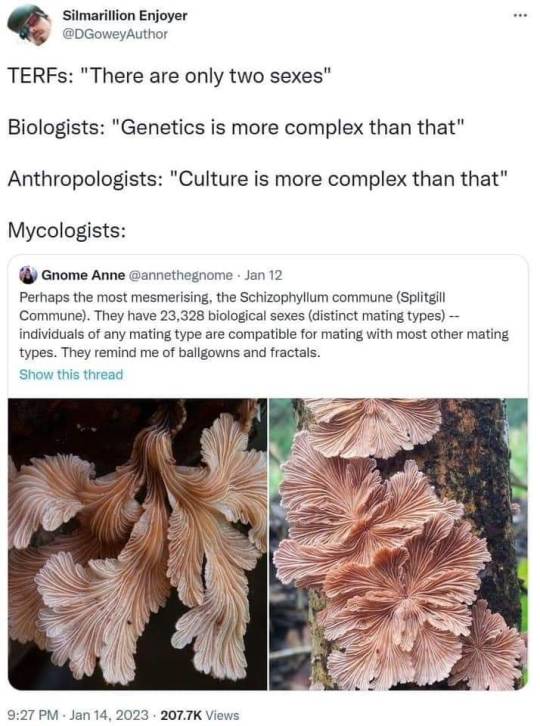
59K notes
·
View notes
Text
Phoroncidia lygeana
This species occurs in South-Eastern Asia, but besides that it mostly remains a mystery for now . . .
@hispaatra, @zick-the-fairy unortunately, there is very little to find on this fella, I hope you find him interesting, nonetheless :DD


Description
I will preface this description by mentioning that I could find very little on this species of spiders, so the information I give on the spider will lean more towards speculation than facts. The information on fluorescence and under 'Distribution and habitat', however, is backed up by a reference.
Phoroncidia lygeana seems to be a rather small species of spider, eye-balling it, I would guess the spider approximately measures up to 1 centimetre in length, give or take 5 millimetres.
It seems to have six spikes portruding from its carapace. Besides that, it glows under UV-light, meaning fluorescence occurs in this species and there are most likely fluorophores in its exoskeleton.
"Fluorescence occurs when molecules called fluorophores absorb light at one wavelength and then emit light at a longer wavelength."
More on fluorescence in arachnids for those interested:
Andrews Kindra, Reed Scott M. and Masta Susan E. (2007) Spiders fluoresce variably across many taxa. Biol. Lett. 3265–267 http://doi.org/10.1098/rsbl.2007.0016
Distribution and habitat
This species has been recorded in Indonesia in the late 19th-century. It is very rare in Singapore and does not appear outside Bukit Timah Hill. Nevertheless, this spider is sporadically common in primary and secondary forests in Malaysia and Brunei.
Phoroncidia lygeana appears to inhabit forests and terrestrial habitats.
~~~~~~~~~~~~~~~~~~~~~~~~~~~~~~~~~~~~~~~~~
Image sources:
1.
https://www.inaturalist.org/observations/96532902
2.
https://www.inaturalist.org/observations/131189234
~~~~~~~~~~~~~~~~~~~~~~~~~~~~~~~~~~~~~~~~~
Text references:
1.
Andrews Kindra, Reed Scott M. and Masta Susan E. (2007) Spiders fluoresce variably across many taxa. Biol. Lett. 3265–267 http://doi.org/10.1098/rsbl.2007.0016
2.
https://www.nparks.gov.sg/florafaunaweb/fauna/3/5/352
32 notes
·
View notes
Text
Thwaitesia margaritifera
This here is an excellent example of a gorgeous species which is, unfortunately, very poorly researched. What is very interesting is that those specks on its body can change in size ! ! ! It reminds me a bit of our pupils and how they react to light, it is fascinating ! !
@hispaatra, @zick-the-fairy you might really like this spider ! ! ! :DD


Description
This spider is very small in size, around 4 to 5 millimetres in length. They have reflective silvery patches on their abdomen. The scales ressemble mirrors a bit, but they can actually change size depending on how threatened the spider feels. The reflective scales are composed of reflective guanine, which these and other spiders use to give themselves color.
Distribution
Thwaitesia margaritifera is found in China, India, Sri Lanka and Vietnam. However, it has also been found in Australia.
~~~~~~~~~~~~~~~~~~~~~~~~~~~~~~~~~~~~~~~~~
Image sources:
1, 2.
https://inaturalist.ca/observations/228160919
~~~~~~~~~~~~~~~~~~~~~~~~~~~~~~~~~~~~~~~~~
Text references:
1.
https://www.jungledragon.com/image/66888/jewelry_spider_-_thwaitesia_margaritifera.html
2.
https://en.wikipedia.org/wiki/Thwaitesia_margaritifera
3.
https://spideridentifications.com/thwaitesia.html
#hyperfixation#biology#entomology#Thwaitesia margaritifera#spiders#arachnids#bugblr#beloved mutuals#<3
23 notes
·
View notes
Text
They are, indeed, adorable ! ! Their shape is AWESOME ! ! !
Thank you for the additional information ! ! It is amazing ! Who knew these spiders were so thoughtful towards the birds ! ? ! ( jk, I know it is to protect their own webs, but still ) <333
Spinybacked Orbweaver - Gasteracantha cancriformis
This post is on Gasteracantha cancriformis, which is a peculiar looking species of orb-weaver spider which is widely distributed across the American continents.
@hispaatra, @zick-the-fairy you guys need to know about this species, it is so freaking cute ! !
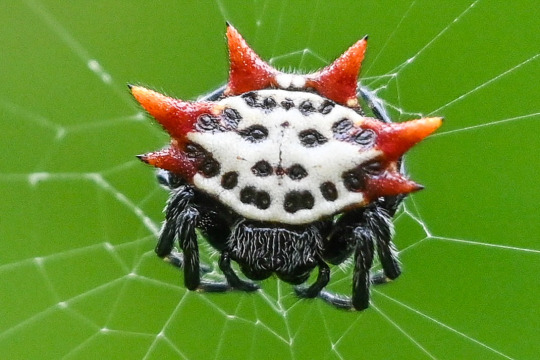
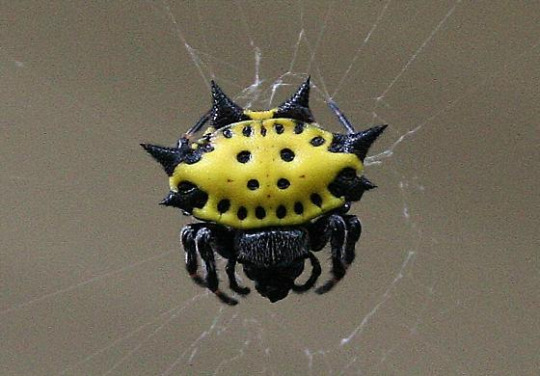
Description
Females measure about 5 to 9 millimetres and 10 to 13 millimetres wide. The six abdominal spine-like projections on the abdomen are characteristic for the species. The carapace, legs, and underside are black with white spots under the abdomen. Variations occur in the colour of the upperside of the abdomen; a white or yellow colour with both featuring black spots. A white upper side can have either red or black spines while a yellow upperside can only have black ones. Like many other spiders, males are much smaller, 2 to 3 millimetres long, and longer than wide. They are similar to the females in colour, but have a gray abdomen with white spots and the spines are reduced to four or five stubby projections.
This species of spider does not live very long. In fact, the lifespan lasts only until reproduction, which usually takes place in the spring following the winter when they hatched. Females die after producing an egg mass, and males die six days after a complete cycle of sperm induction to the female.
Distribution and habitat
The spinybacked orbweaver is native to North America, Central America, the Caribbean and South America up to northern Argentina. It has been introduced elsewhere, including Hawaii. It prefers living around the edge of woodland and shrubby gardens.
Gasteracantha cancriformis is seen to coexist within and on the edges of the colonies of other colonial orb-weaver spiders, mainly Metepeira incrassata, which is known to form large colonies which often accommodate other species of orb-weavers.
~~~~~~~~~~~~~~~~~~~~~~~~~~~~~~~~~~~~~~~~~
Image sources:
1.
https://www.inaturalist.org/taxa/49540-Gasteracantha-cancriformis
2.
https://bugguide.net/node/view/839791/bgimage
~~~~~~~~~~~~~~~~~~~~~~~~~~~~~~~~~~~~~~~~~
Text references:
1.
https://en.wikipedia.org/wiki/Gasteracantha_cancriformis
2.
https://edis.ifas.ufl.edu/publication/IN324
3.
https://wsc.nmbe.ch/species/3986
34 notes
·
View notes
Text
Spinybacked Orbweaver - Gasteracantha cancriformis
This post is on Gasteracantha cancriformis, which is a peculiar looking species of orb-weaver spider which is widely distributed across the American continents.
@hispaatra, @zick-the-fairy you guys need to know about this species, it is so freaking cute ! !


Description
Females measure about 5 to 9 millimetres and 10 to 13 millimetres wide. The six abdominal spine-like projections on the abdomen are characteristic for the species. The carapace, legs, and underside are black with white spots under the abdomen. Variations occur in the colour of the upperside of the abdomen; a white or yellow colour with both featuring black spots. A white upper side can have either red or black spines while a yellow upperside can only have black ones. Like many other spiders, males are much smaller, 2 to 3 millimetres long, and longer than wide. They are similar to the females in colour, but have a gray abdomen with white spots and the spines are reduced to four or five stubby projections.
This species of spider does not live very long. In fact, the lifespan lasts only until reproduction, which usually takes place in the spring following the winter when they hatched. Females die after producing an egg mass, and males die six days after a complete cycle of sperm induction to the female.
Distribution and habitat
The spinybacked orbweaver is native to North America, Central America, the Caribbean and South America up to northern Argentina. It has been introduced elsewhere, including Hawaii. It prefers living around the edge of woodland and shrubby gardens.
Gasteracantha cancriformis is seen to coexist within and on the edges of the colonies of other colonial orb-weaver spiders, mainly Metepeira incrassata, which is known to form large colonies which often accommodate other species of orb-weavers.
~~~~~~~~~~~~~~~~~~~~~~~~~~~~~~~~~~~~~~~~~
Image sources:
1.
https://www.inaturalist.org/taxa/49540-Gasteracantha-cancriformis
2.
https://bugguide.net/node/view/839791/bgimage
~~~~~~~~~~~~~~~~~~~~~~~~~~~~~~~~~~~~~~~~~
Text references:
1.
https://en.wikipedia.org/wiki/Gasteracantha_cancriformis
2.
https://edis.ifas.ufl.edu/publication/IN324
3.
https://wsc.nmbe.ch/species/3986
#hyperfixation#biology#entomology#Spinybacked Orbweaver#Gasteracantha cancriformis#spiders#arachnids#bugblr#beloved mutuals#<3
34 notes
·
View notes
Text
Floral egg crab - Atergatis floridus
This is the floral egg crab, or Atergatis floridus, a beautiful but poisonous crab that can be found in the tropical Indo-Pacific.
@hispaatra here is the pretty green crab ! ! :DD


Description
Atergatis floridus has an oval, relatively narrow carapace which has a smooth surface and smooth margins. The carapace is greenish or greenish-blue-brown and is marked with a lace-like pattern and is made up of a fine network of fine white or yellow lines. It has large claws which are equal sizes and which are smooth with black spoon-shaped tips and which may be larger in males than females. The pereiopods are squarish in shape and quite thick with lilac edges. The width of the carapace is 8 to 10 centimetres.
Distribution and habitat
Atergatis floridus can be found in the eastern Indian Ocean from south east Asia, south to Australia where it reaches Rottnest Island in Western Australia and possibly Sydney in the east, its range extends eastwards across the western pacific as far as Hawaii.
It is an inhabitant of the neritic zone and prefers coral and rubble, it is also largely nocturnal. Atergatis floridus is a host to the isopod Gigantione hainanensis and the rhizocephalan barnacles Loxothylacus aristatus, Loxothylacus corculum, Sacculina gordonae, Sacculina robusta, Sacculina spinosa and Sacculina weberi.
Bonus
Here is a cute poststamp with Atergatis floridus on it :

~~~~~~~~~~~~~~~~~~~~~~~~~~~~~~~~~~~~~~~~~
Image sources:
1.
https://nl.pinterest.com/pin/402298179242522124/
2.
https://www.inaturalist.org/taxa/469186-Atergatis-floridus
3.
https://www.marinespecies.org/aphia.php?p=image&pic=18709&tid=209061
~~~~~~~~~~~~~~~~~~~~~~~~~~~~~~~~~~~~~~~~~
Text references:
1.
https://en.wikipedia.org/wiki/Atergatis_floridus
2.
http://www.wildsingapore.com/wildfacts/crustacea/crab/xanthidae/floridus.htm
#hyperfixation#biology#aquatic biology#marine biology#Floral egg crab#Atergatis floridus#crabs#beloved mutuals#<3
67 notes
·
View notes
Text
Definitely friend-shaped ! ! Very mindful, very demure <333
You are literally the best for always finding these videos on the bugs ! ! Thank you so much <333 It is incredibly interesting :DDD
Elephant beetle - Megasoma elephas
Here is another info-post, this time on an awesome puppy-sized beetle known as an elephant beetle, or Megasoma elephas.
@hispaatra Researched the puppy beetle :DD


Description
Elephant beetles are black in color and covered with a coat of fine microscopic hairs, in other words their body is hirsute. The hairs grow particularly thick on the beetle's elytra. The hairs give the beetle's body a yellowish colour. Males have two horns protruding from the head and another from the prothorax. The longest head horn gives the beetle its common name, since it resembles an elephant’s trunk. Females have no horns. The horns are used for defense, and in competition among males for food and mates.
In size, elephant beetles typically range between 7 and 12 centimetres. The largest male specimen, that we know of, measures 13.7 centimetres, including the horn.
Diet
For their diet, elephant beetles eat the sap of particular trees and ripened fallen fruits. In captivity, they also eat fruits such as pineapples, longan, lychee fruit, and bark from certain trees like the poinciana.
Breeding
Megasoma elephas larvae develop in large decaying logs or the ground, where the female beetle lays her eggs. Some weeks after that, usually three, the eggs hatch into C-shaped larvae, white grubs with brown heads and six legs. The larval stage lasts around 29 months, during which time the grubs consume organic matter. The third and last stage, the pupal stage, lasts around five weeks at a temperature of 26 degrees Celsius. The life span of an adult elephant beetle is around one to three months.
Distribution and habitat
Elephant beetles can be found in southern Mexico, Central America, and in South American rainforests.
Elephant beetles live in rainforests and are mainly active during the night. They are also able to maintain a high internal body heat when foraging despite reduced ambient temperature.
~~~~~~~~~~~~~~~~~~~~~~~~~~~~~~~~~~~~~~~~~
Image sources:
1.
https://nl.pinterest.com/pin/1477812351560073/
2.
https://nl.pinterest.com/pin/20055160839071562/
~~~~~~~~~~~~~~~~~~~~~~~~~~~~~~~~~~~~~~~~~
Text references:
1.
https://en.wikipedia.org/wiki/Elephant_beetle
2.
https://www.grida.no/resources/1901
3.
https://www.inaturalist.org/taxa/122000-Megasoma-elephas
141 notes
·
View notes
Text
Hetschkia gracilis
Sooo this spider looks like a jelly candy, or a gummy, or a whatever you wish to call it . . . eitherwayy it is super gorgeous ! ! !
@hispaatra you need to see this ! !


This spider is from Brazil and is only about 2 millimetres long, give or take 0.2 millimetres ! That is insane ! It is so cool !
~~~~~~~~~~~~~~~~~~~~~~~~~~~~~~~~~~~~~~~~~
Image sources:
1, 2.
https://www.inaturalist.org/observations/236615319
~~~~~~~~~~~~~~~~~~~~~~~~~~~~~~~~~~~~~~~~~
Text reference:
1.
https://web.archive.org/web/20060926103958/http://psyche2.entclub.org/articles/70/70-170.pdf
23 notes
·
View notes
Text
Elephant beetle - Megasoma elephas
Here is another info-post, this time on an awesome puppy-sized beetle known as an elephant beetle, or Megasoma elephas.
@hispaatra Researched the puppy beetle :DD


Description
Elephant beetles are black in color and covered with a coat of fine microscopic hairs, in other words their body is hirsute. The hairs grow particularly thick on the beetle's elytra. The hairs give the beetle's body a yellowish colour. Males have two horns protruding from the head and another from the prothorax. The longest head horn gives the beetle its common name, since it resembles an elephant’s trunk. Females have no horns. The horns are used for defense, and in competition among males for food and mates.
In size, elephant beetles typically range between 7 and 12 centimetres. The largest male specimen, that we know of, measures 13.7 centimetres, including the horn.
Diet
For their diet, elephant beetles eat the sap of particular trees and ripened fallen fruits. In captivity, they also eat fruits such as pineapples, longan, lychee fruit, and bark from certain trees like the poinciana.
Breeding
Megasoma elephas larvae develop in large decaying logs or the ground, where the female beetle lays her eggs. Some weeks after that, usually three, the eggs hatch into C-shaped larvae, white grubs with brown heads and six legs. The larval stage lasts around 29 months, during which time the grubs consume organic matter. The third and last stage, the pupal stage, lasts around five weeks at a temperature of 26 degrees Celsius. The life span of an adult elephant beetle is around one to three months.
Distribution and habitat
Elephant beetles can be found in southern Mexico, Central America, and in South American rainforests.
Elephant beetles live in rainforests and are mainly active during the night. They are also able to maintain a high internal body heat when foraging despite reduced ambient temperature.
~~~~~~~~~~~~~~~~~~~~~~~~~~~~~~~~~~~~~~~~~
Image sources:
1.
https://nl.pinterest.com/pin/1477812351560073/
2.
https://nl.pinterest.com/pin/20055160839071562/
~~~~~~~~~~~~~~~~~~~~~~~~~~~~~~~~~~~~~~~~~
Text references:
1.
https://en.wikipedia.org/wiki/Elephant_beetle
2.
https://www.grida.no/resources/1901
3.
https://www.inaturalist.org/taxa/122000-Megasoma-elephas
#hyperfixation#biology#entomology#elephant beetle#Megasoma elephas#beetle#beetles#bugs#insects#bugblr#beloved mutuals#<3
141 notes
·
View notes
Text
Fringed Leaf Frog - Cruziohyla craspedopus
@hispaatra another gorgeous frog ! It literally looks like the embodiment of the summer, yellow for the sun and cyan for the ocean.

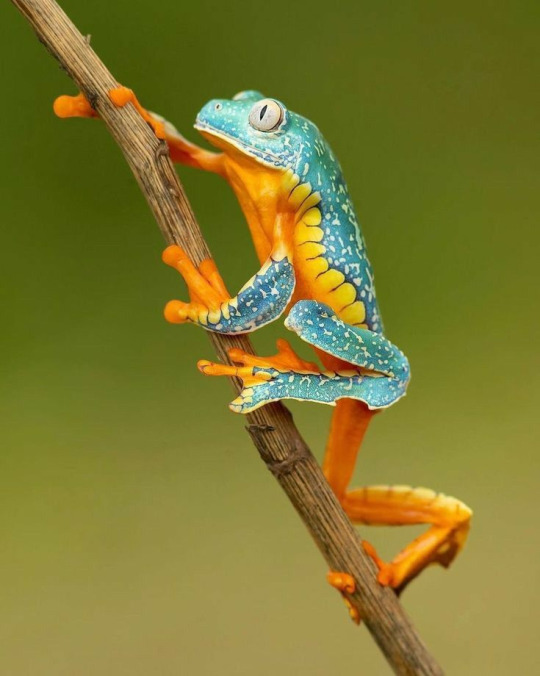
Description
Adult males measure 53 to 66 millimetres and adult females 68 to 76 millimetres in snout–vent length. The head is slightly wider than it is long and the snout is sharply truncate in lateral view. The fingers and toes are webbed. The hind margin of the tarsus bear extensive dermal appendages forming irregular spurs. The dorsum has uniform dark green dorsal background coloration interspersed with irregular-shaped large pale blue-grey lichenose blotches. The flanks have narrow black lines. The undersides and concealed surfaces of the flanks and legs are yellow. When adhered to a surface, the yellow coloration becomes concealed which can aid in camouflage.
Colour adaptation - camouflage
Cruziohyla craspedopus displays a burgundy pigmentation at night. This ability to rapidly colour-adapt is caused by levels of the hormone, intermedin, and its effects on chromatophore structure. The dermal chromatophore unit includes xanthophores, iridophores, and melanophores, which function together to display or inhibit certain colouring.
The movement of melanosomes to melanophore fingers conceals the light-reflecting iridisphore layer, dictating a darker pigmentation at night. Whereas, the absence of melanosomes in the fingers allows for quick blanching.
Distribution and habitat
It is found in the Amazonian lowlands in Brazil, Colombia, Ecuador, and Peru, and Bolivia.
Cruziohyla craspedopus is a high-canopy frog of primary tropical lowland rainforest at elevations of 50 to 600 metres above sea level. It only descends to lower branches for breeding, which takes place in fallen trees holding small water pools. However, tadpoles have also been found in small pools on the ground.
~~~~~~~~~~~~~~~~~~~~~~~~~~~~~~~~~~~~~~~~~
Image sources:
1.
https://nl.pinterest.com/pin/3518505954284492/
2.
https://nl.pinterest.com/pin/88735055151007930/
~~~~~~~~~~~~~~~~~~~~~~~~~~~~~~~~~~~~~~~~~
Text references:
1.
https://en.wikipedia.org/wiki/Cruziohyla_craspedopus
2.
https://www.iucnredlist.org/species/55291/85897508
3.
https://amphibiaweb.org/species/617
#hyperfixation#biology#herpetology#Fringed Leaf Frog#Cruziohyla craspedopus#frogs#frogblr#beloved mutuals#<3
32 notes
·
View notes
Text
YES WE ARE ! ! ! :DD
And you are absolutely right ! He is so fashionable, could go right in the Vogue ! !
Indian black microhylid frog - Melanobatrachus indicus
This stunning frog, on the internet better known as a galaxy frog, is endemic to southern India where it inhabits wet evergreen forests. Unfortunately, this species is endangered.
@hispaatra more FROGS ! ! ! :D


Description
Melanobatrachus indicus is a rare frog with a slender, elongated bodied of uniform width. The snout-vent length is reported as 24 up to about 32 millimetres. The head is wider than long and the short snout length is longer than the eye diameter and the interorbital distance. There is no canthus rostralis or cranial ridges. The pupils are circular and the eye diameter is greater than the distance between the eyes. There is no tympanum or parotid gland. The mouth has a cleft that extends towards the eyelid.
The skin on the dorsum of the head and body, and on the hind limbs are covered in tubercles. The arms, flanks, and ventrum are smooth.
The fingers are unwebbed and not dilated at the tips. The third finger is twice the length as the other fingers. The fourth finger is short. The hind limbs are about the same length as the snout-vent length with the thigh being shorter than the shank. The cylindrical toes have basal webbing and are undilated at the tips. The fourth toe is much longer than the third.
The dorsum is black with small white dots. The ventrum sometimes has a few scarlet blotches on the anterior region of chest that can extend to the upper arms and humerus. There are larger white dots on the belly. There is a broad scarlet band across the ventral surface of its thighs near to the groin area that can completely encircle the thighs. The aposematic coloration of the belly and limbs remain largely hidden when the species exhibits anti-predator, contraction behavior.
Distribution and habitat
It is endemic to wet evergreen forests of southern Western Ghats in Kerala and Tamil Nadu states of India at heights of 1000 to 1500 metres above sea level. It has been recorded from Anaimalai, Munnar, Palni hills, Periyar Tiger Reserve and Kalakkad Mundanthurai Tiger Reserve. It lives amongst leaf-litter, rocks and other ground cover of moist evergreen tropical forests.
~~~~~~~~~~~~~~~~~~~~~~~~~~~~~~~~~~~~~~~~~
Image sources:
1.
https://nl.pinterest.com/pin/364932376096529147/
2.
https://www.tumblr.com/herpsandbirds/752935777799946240/indian-black-narrowmouth-frog-aka-space-frog
~~~~~~~~~~~~~~~~~~~~~~~~~~~~~~~~~~~~~~~~~
Text reference
1.
https://www.iucnredlist.org/species/13032/166095464
2.
https://en.wikipedia.org/wiki/Melanobatrachus
3.
https://amphibiaweb.org/species/2229
19 notes
·
View notes
Text
WEEVIL SPOTTED ! ! ! THE MATCHING BRACELET IS ICONOC, ALWAYS PREPARED ! ! <333


You guys will NEVER believe the kind of legendary encounter i just had... i was so very ready for this
46 notes
·
View notes
Text
Plain nawab - Polyura hebe
Who knew dragons were real ? It is incredible, the ressemblence that the plain nawab caterpillar carries ! ! And the butterfly is stunning too, with colours such as auburn and cyan on its wings !
@hispaatra, @zick-the-fairy you will this butterfly, it is so neat ! !
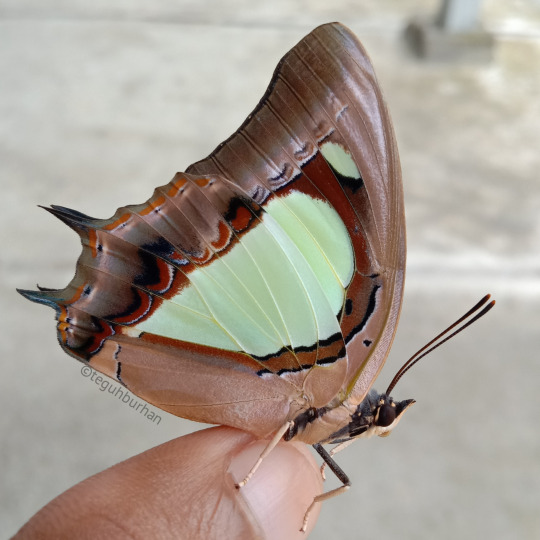

Description
The caterpillar is a bright green colour, taking the colour of the green Saga leaves, onto which it very effectively merges as it camouflages itself. The four-horned head is black to green in the early instars. As the caterpillar grows larger, it takes on a two-shade green appearance, with triangular wedge-shaped stripes along the length of its body.
Polyura hebe has a wingspan of about 65 millimetres. In these medium-sized, heavy-bodies butterflies the outer edge of the forewings is concave, with a pointed apex and the hindwings show two short tails. The upperside of the wings is greenish white. A broad dark brown apical border, wide at the apex, but decreasing in width towards the base of the costa, forms a wide internal greenish-white band. Also the hindwings show a broad dark brown border, with submarginal small white marks. The underside is brown and has a wide pale silvery-green median patch.
Diet
Larvae feed on several plant of the family Leguminosae, sub-family Mimosoideae, mainly red saga (Adenanthera pavonina), Albizia falcata, Falcataria moluccana, and petai (Parkia speciosa).
Distribution
This species can be found in Burma, Malaysia, Thailand, Singapore, Java, Sumatra, Bali, and Borneo.
~~~~~~~~~~~~~~~~~~~~~~~~~~~~~~~~~~~~~~~~~
Image sources:
1.
https://www.inaturalist.org/observations/149456191
2.
https://www.flickr.com/photos/hdshchen/39481098340
~~~~~~~~~~~~~~~~~~~~~~~~~~~~~~~~~~~~~~~~~
Text references:
1.
https://en.wikipedia.org/wiki/Polyura_hebe
2.
https://web.archive.org/web/20091027212630/http://butterfly.nss.org.sg/expert/Polyura-hebe/polyura-hebe.htm
3.
https://butterflycircle.blogspot.com/2009/02/life-history-of-plain-nawab.html
#hyperfixation#biology#entomology#plain nawab#Polyura hebe#butterfly#caterpillars#bugs#insects#bugblr#beloved mutuals#<3
26 notes
·
View notes
Text
SPOOKY PLANTS AND FUNGI - LINKS
Ghost pipe - Monotropa uniflora
Spooky Fungi
Black elfin saddle - Helvella lacunosa
White elfin crispa - Helvella crispa
Candy apple bolete - Exsudoporus frostii
Beefsteak mushroom - Fistulina hepatica
Witches' butter - Tremella mesenterica
Black witches' butter - Exidia glandulosa
Zombie fungus - Ophiocordyceps
10 notes
·
View notes
Text
MYCOLOGY - LINKS
Shaggy Inkcap - Coprinus comatus
Devil's tooth - Hydnellum peckii
Small staghorn - Calocera cornea
Pixie's parasols - Mycena interrupta
Mycena subcyanocephala
Night light mushroom - Mycena chlorophos
Candida aureus
Alternia solani
Nidulariaceae and gemmae cups similarities
Panthercap - Amanita pantherina
Parasol - Macrolepiota procera
Chrondrostereum purpureum
Wrinkled Peach - Rhodotus palmatus
Parrot Waxcap - Gliophorus psittacinus (1)
Parrot Waxcap - Gliophorus psittacinus (2)
23 notes
·
View notes
Text
MARINE BIOLOGY - LINKS
Harriotta avia
Pictures from the Aquarium
Whiptail Gulper Eel - Saccopharynx lavenbergi
Volcano snail - Chrysomallon squamiferum
Floral egg crab - Atergatis floridus
2 notes
·
View notes
Text
HERPETOLOGY - LINKS
Vietnamese mossy frog - Theloderma corticale
Amazon milk frog - Trachycephalus resinifictrix
Rio Pescado stubfoot toad - Atelopus balios
Purple harlequin toad - Atelopus barbotini
Indian black microhylid frog - Melanobatrachus indicus
Fringed Leaf Frog - Cruziohyla craspedopus
2 notes
·
View notes